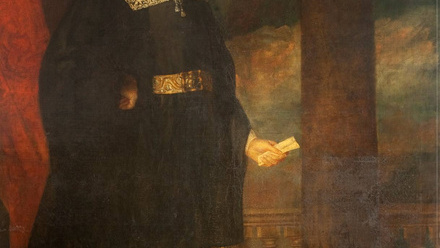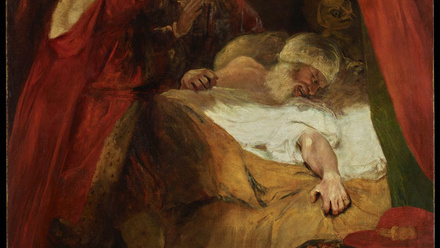The Dig was released on Netflix at the end of January. The film is based on John Preston's historical novel and explores the story of the discovery in 1939 of the famous Anglo-Saxon ship burial at Sutton Hoo. It focuses on the dig’s protagonists, in particular the archaeologist Basil Brown and Edith Pretty, the owner of the Sutton Hoo estate who instigated the first excavation of the site.
But we conservators, have our very own protagonist in this fascinating story who, some 30 years later, played a key role in unlocking the secrets of one of the most magnificent archaeological discoveries of all time. This was of course Nigel Williams, Head of Ceramics and Glass Section in the Department of Conservation at the British Museum, who in 1966 was chosen to head a small team charged with the conservation of the finds.
When it was found, the helmet was in hundreds of pieces.
Nigel joined the museum in 1961, aged just 16, as a Museum Assistant in the department of British and Medieval Antiquities, after completing his studies in silversmithing and metal design and, later, in conservation. A decade later, he was embarking in one of the most challenging conservation projects ever: the dismantling and reconstruction of the Sutton Hoo helmet. When it was found, the helmet was in hundreds of pieces. It was initially pieced together in the 1940s, but this early reconstruction was highly contested, and a decision was made to take the helmet apart and attempt a more accurate reconstruction.

In 1971, Nigel began the painstaking work of dismantling the helmet. In the words of his colleague, curator Angela Care Evans, this ‘was like opening a little box of horrors’. For over six months, more than 500 fragments lay on Nigel’s workbench while he, as fellow conservator Ian McIntyre puts it, ‘subconsciously absorbed the shape of fragments’, looking for joins. The process was incredibly slow, each step requiring discussions with other experts. Finally, after a year of careful study of the profile, colour and morphology of each fragment, including those that were omitted in the first reconstruction, the work on the helmet was complete. Nigel received high praise for his work.
The fragments were mounted on a heavy-duty textile covered with plaster, which both formed the shape of the helmet and supported the fragments. Alongside the helmet, Nigel conserved several other finds from the burial, including a shield, drinking horns, tubs and buckets. In summer 1967, he was part of a team that undertook the mammoth task of making a complete 90ft-long cast of the ship itself. Footage of the complex and ambitious task was captured by the BBC and can be viewed online.
Nigel’s passion for challenging projects was the stuff of legend among his colleagues, and most conservators could only dream of a career like his
Nigel’s passion for challenging projects was the stuff of legend among his colleagues, and most conservators could only dream of a career like his. After his work on the Sutton Hoo finds he completed two equally epic reconstructions.The first involved assembling thousands of fragments of Greek vases found during the exploration of the shipwreck of the HMS Colossus, which went down in 1789 off the Scilly Isles.
The second, his most impressive feat of all, was the reconstruction of the Portland Vase. It is this project for which he is most widely revered. The vase, one of the best surviving Roman glasses, was famously smashed by a vandal while on display in 1845 and subsequently underwent two restorations. In the 1980s, the failing and yellowing adhesive of those interventions made a new reconstruction unavoidable and Nigel, alongside his colleague Sandra Smith ACR, was put in charge of its conservation. The reconstruction required the adhering together of some 200 fragments, a process which took a whole year. This endeavour featured in the BBC series ‘Chronicle’. Nigel’s enthusiasm and passion for conservation captured the public imagination and brought conservation closer to a wide audience.
Nigel's expertise led him to be invited to deliver lectures around the world. Although he worked on a wide variety of materials throughout his career, Nigel’s passion resided with ceramics and glass and his vast knowledge led him to publish ‘Porcelain: Repair and Restoration’ (1983), at a time when no authoritative books about museum practice in ceramic restoration existed.
Nigel’s sudden death in 1994 left a huge hole in the conservation community. The Icon Ceramics & Glass Group, of which he had been a member, wanted to ensure that Nigel’s great passion for conservation and his commitment to advancing the profession lived on. This led to the creation in 2002 of the Nigel Williams Prize to serve both as a memorial to Nigel’s work and to encourage continued high standards at all levels within the profession. The Prize rewards outstanding projects by professionals and students in in the conservation and restoration of ceramic, glass or a related material and is awarded every two years. The trophy for the Prize is an especially made ceramic and 24-carat gold copy of the Portland vase, donated by Wedgwood.
To find out more about Nigel and the Prize, visit the Ceramics and Glass page.
References:
- Kenneth S. Painter, Nigel Williams (1944–1992), Journal of Glass Studies, Vol. 35 (1993), pp. 158-159. Published by: Corning Museum of Glass https://www.jstor.org/stable/24191075?seq=2#metadata_info_tab_contents
- Documentary: 1/2 The Sutton Hoo Helmet - Masterpieces of the British Museum
- Rupert Bruce-Mitford, The Sutton Hoo Helmet: A New Reconstruction, The British Museum Quarterly, Autumn, 1972, Vol. 36, pp. 120-130 Published by: British Museum Stable
Header image: replica of the helmet from the Sutton Hoo ship-burial. Creative Commons Attribution-Share Alike 3.0 Unported, 2.5 Generic, 2.0 Generic and 1.0 Generic license.






